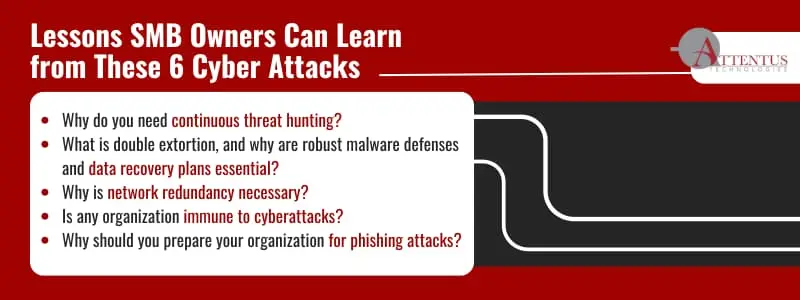The iron-clad rule of cyberattacks is that they come in many forms, from all directions, and from incredibly different sources.

Are you proactively protecting your SMB against cyberthreats? Attackers today use varying tactics to compromise organizations, and understanding them can help secure your valuable data while also ensuring your operations run uninterrupted.
Let’s explore six lessons from modern-day attacks that highlight why cybersecurity best practices such as continuous monitoring, secure storage, and solid backup disaster recovery (BDR) plans are essential.
Here’s everything you need to know.
1. Attackers are finding (and weaponizing) flaws that nobody knows even exist
In 2025, the Clop ransomware gang breached WK Kellogg Co., targeting employee data such as names, Social Security numbers, and other sensitive information.
Reports say they exploited two zero-day vulnerabilities in Cleo, a file transfer software Kellogg was using. These were brand-new flaws, unknown to the vendor, so no patch was available.
Zero-day vulnerabilities like these are incredibly dangerous because they often go unnoticed, and there’s no immediate fix. You may have an undiscovered flaw, even if you’re patching regularly, so you need 24/7 monitoring and threat hunting to find them before attackers do.
2. Encrypting and stealing data is the new hacker playbook
Speaking of ransomware tactics, have you heard about Rhysida? This group and others like them use double extortion, according to the Cybersecurity and Infrastructure Security Agency (CISA). They encrypt your files, lock your systems, steal sensitive data, and threaten to leak it publicly if you don’t pay the ransom.
So it’s not just about getting your systems working again. You also face the threat of having your confidential data, customer information, employee records, and trade secrets put online. That means you need a robust malware defense and data recovery plan as part of your cybersecurity best practices.
3. You need redundancy if an attack cripples your primary network
In 2000, Michael Calce, who was 15 years old and known as Mafiaboy, claimed he had unknowingly input several widely known IP addresses into a security tool he downloaded from the web.
Like any teenager, Calce went off to school as usual, but found his exploits plastered all over the news upon returning home.
Denial of service attacks, like Mafiaboy, flood a site with traffic to disable its ability to serve legitimate users. Yahoo was the world’s most-used search engine at the time, and it collapsed. Buy.com, eBay, CNN, and Amazon were all brought down by similar attacks for several hours, resulting in billions of dollars in lost revenue and costs.
This attack highlights the need for a redundant network to fall back on in the event of disaster.
4. No one is immune to cyberattacks
A hacker named Jonathan James breached the U.S. Department of Defense in 1999, stealing passwords, confidential messages, and software designed for space exploration in the U.S. military. NASA had to shut down its entire network for three weeks, with the brute force attacks costing millions.
The key takeaway is that no organization is too big or small to get breached.
5. Every organization needs immutable and quickly recoverable backups
In 2014, the Guardians of Peace (or GOP), also known as the Lazarus Group, attacked Sony Pictures and released a trove of sensitive data like personal information, messages and correspondence, executive salaries, and several of Sony’s films.
The group used a modified Shamoon wiper malware with a mechanism to wipe hard drives. This hurts victims by deleting their valuable information, reinforcing the need to have backup data protection in addition to malware defence in your cybersecurity best practices.
6. Phishing attacks will keep evolving, and you need to be ready
David L. Smith might be the founder of phishing attacks. He posted a document to an America Online chat room in 1999 claiming to have credentials to several websites, but the actual content was the Melissa virus, according to the FBI.
Melissa then went viral and spread across global email servers. Several tech-savvy companies (including Lockheed Martin, Intel, and Microsoft) were forced to shut down their email services after Melissa caused over $80 million in damages.
Fast forward to 2025, and phishing remains a top threat. It has unfortunately evolved with AI, which now allows attackers to craft persuasive phishing messages at scale.
Are you teaching your employees cybersecurity best practices to navigate this new era?
Thwart Attacks with Security Improvements
Cyberattacks aren’t going away any time soon. They’re evolving and hitting everyone from universities and governments to businesses. The attackers are getting smarter, too, using zero-day exploits, double extortion, and other tactics to get through.
Understanding the threat is step one, but implementing cybersecurity best practices is what protects you.
Lock your focus on cyber resilience with the help of Attentus Technologies, and you can withstand the unending parade of attacks. We’re not a “break, then fix” agency. We take proactivity seriously, because expensive lessons are best avoided…maintaining strong security practices and clear visibility before it’s too late reduces your attack surface significantly.
Curious about where to start? Read our security improvements blog to discover four practices you can implement today.
